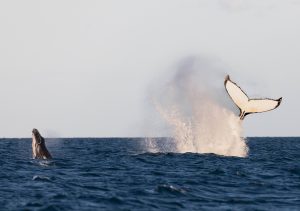THE GREAT MIGRATION: WITNESS THE HUMPBACK WHALES OF THE KIMBERLEY
by Will Gilmore
A New Season Unfolds
As the dry season takes hold of the Kimberley and the iconic roar of the King George, Mitchell, and Berkeley Falls begins to subside, another of nature’s great spectacles gains momentum. At this time of year, falling sea surface temperatures, calmer seas, and reduced cyclonic activity signal the arrival of the west coast’s winter visitors — the humpback whales.
An Epic Journey Begins
Western Australia’s humpback whale population is estimated at around 30,000. Each year, they embark on one of the longest mammalian migrations on Earth — a 10,000-kilometre journey from the icy, nutrient-rich waters of the Antarctic to the warm, sheltered breeding grounds off Australia’s west coast.
First Arrivals and Courtship Displays
By late May or early June, the first whales, usually juveniles, begin to appear along the coastline. Watchers may observe spectacular surface behaviours such as breaching, tail slapping, lunging, and pectoral fin displays. These dramatic actions announce their arrival.
Soon after, adult males arrive in search of a mate. This triggers the dramatic “heat run” — a pod of males competing for a single female’s attention. During these displays, males breach, throw their tails, and slap their five-tonne pectoral fins to outshine their rivals. As a result, these testosterone-fuelled encounters can be astonishing to witness.

Calving in Camden Sound
By late July and into August, the humpback season reaches its peak. Pregnant females arrive in Camden Sound and other sheltered bays of the Kimberley to give birth. Because of their calm, protected waters, these bays offer ideal conditions for newborn calves.
Calves are born at 3 to 5 meters long and weigh around 500 kilograms. Over the following months, they grow rapidly on nutrient-rich milk, which contains up to 50% fat. Meanwhile, visitors can often observe the young whales learning to breach and tail slap, building strength for the long journey south.
The Southern Migration Begins
By early November, the last whales are sighted along the southern coastline as the migration winds down. Mothers and calves — now up to 9 metres in length — begin their return to the Antarctic feeding grounds. At the same time, newly pregnant females replenish their body fat after a year of intense parenting, which may have cost them up to a third of their body weight.
See It All With Coral Expeditions
Fortunately, this incredible migration can be experienced from the decks of Coral Expeditions’ small ships on Kimberley Cruises between Darwin and Broome, departing July to September. These journeys pass through key calving areas and offer unforgettable encounters with a new generation of whales.
Additionally, those travelling on the Abrolhos Islands & Coral Coast Voyages between Broome and Fremantle in August can witness the full arc of the migration. With each hour spent on deck, the chances of observing rare and powerful behaviours increase. Guests aboard Coral Expeditions enjoy front-row seats to one of the greatest wildlife events on Earth, set against the spectacular and remote beauty of Western Australia’s rugged coast.






